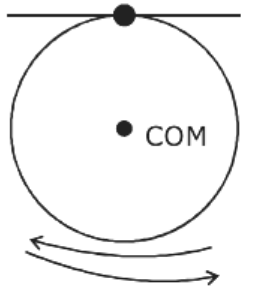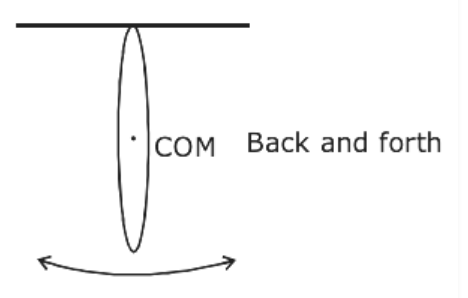
A ring is hung on a nail. It can oscillate, without slipping or sliding
(i) in its plane with a time period $T_1$ and,
(ii) back and forth in a direction perpendicular to its plane, with a period $T_2$.
The ratio $\dfrac{{{T_1}}}{{{T_2}}}$will be:
A. $\dfrac{3}{{\sqrt 2 }}$
B. $\dfrac{{\sqrt 2 }}{3}$
C. $\dfrac{2}{{\sqrt 3 }}$
D. $\dfrac{2}{3}$
Answer
220.8k+ views
Hint:The ring is used as a physical pendulum to determine its time period. The ring's centre of mass and moment of inertia are computed and compared to the appropriate equation for this physical pendulum.
Formula Used:
$T = 2\pi \sqrt {\dfrac{I}{{Mg{l_{cm}}}}} $
Complete answer:
First case:
The first scenario, where the ring is suspended at a location on its rim and oscillates so that the centre travels in its own plane, can be represented by the diagram below.

For a physical pendulum, time period is given by,
$T = 2\pi \sqrt {\dfrac{I}{{Mg{l_{cm}}}}} $
Where,
I is the moment of inertia of the pendulum about the axis of its support,
M is the mass of the pendulum
g is the acceleration due to gravity
${l_{cm}}$ is the distance of the centre of mass of the pendulum from the point of support.
Moment of inertia is the property of a body that prevents it from resisting angular acceleration. It is calculated by multiplying each particle's mass times the square of its distance from the axis of rotation.
Since a ring is suspended from its rim in the first scenario, its centre of mass is in the centre, making the radius of the ring $R$ the distance between the centre of mass and the support,
$ \Rightarrow {l_{cm}} = R$
The moment of inertia of a ring about its diameter is given by
${I_1} = M{R^2}$
We require the moment of inertia about its tangent, because this is where it is attached to the support.
By the parallel axis theorem. The distance between the axis of diameter and the axis of support is $R$
Therefore,
${I_1} = M{R^2} + M{R^2} = 2M{R^2}$
Substituting all of these values in the equation for time period we get,
${T_1} = 2\pi \sqrt {\dfrac{{{I_1}}}{{Mg{l_{cm}}}}} = 2\pi \sqrt {\dfrac{{2M{R^2}}}{{MgR}}} $
${T_1} = 2\pi \sqrt {\dfrac{{2R}}{g}} $
For second case

${I_2} = \dfrac{3}{2}M{R^2}$
$ \Rightarrow {T_2} = 2\pi \sqrt {\dfrac{{{I_2}}}{{Mg{l_{cm}}}}} = 2\pi \sqrt {\dfrac{{\dfrac{3}{2}M{R^2}}}{{MgR}}} $
${T_2} = 2\pi \sqrt {\dfrac{{3R}}{{2g}}} $
Taking the ratio we get, $\dfrac{{{T_1}}}{{{T_2}}} = \sqrt {\dfrac{4}{3}} = \dfrac{2}{{\sqrt 3 }}$
Therefore, correct option is (C).
Note:A physical pendulum can be any size or shape, and it can have a distinct centre of mass and moment of inertia. There are two sorts of pendulums: simple and physical. Moment of inertia calculations for both scenarios should be done carefully because they depend on orientation. We are able to apply the axis theorem for simple calculations.
Formula Used:
$T = 2\pi \sqrt {\dfrac{I}{{Mg{l_{cm}}}}} $
Complete answer:
First case:
The first scenario, where the ring is suspended at a location on its rim and oscillates so that the centre travels in its own plane, can be represented by the diagram below.

For a physical pendulum, time period is given by,
$T = 2\pi \sqrt {\dfrac{I}{{Mg{l_{cm}}}}} $
Where,
I is the moment of inertia of the pendulum about the axis of its support,
M is the mass of the pendulum
g is the acceleration due to gravity
${l_{cm}}$ is the distance of the centre of mass of the pendulum from the point of support.
Moment of inertia is the property of a body that prevents it from resisting angular acceleration. It is calculated by multiplying each particle's mass times the square of its distance from the axis of rotation.
Since a ring is suspended from its rim in the first scenario, its centre of mass is in the centre, making the radius of the ring $R$ the distance between the centre of mass and the support,
$ \Rightarrow {l_{cm}} = R$
The moment of inertia of a ring about its diameter is given by
${I_1} = M{R^2}$
We require the moment of inertia about its tangent, because this is where it is attached to the support.
By the parallel axis theorem. The distance between the axis of diameter and the axis of support is $R$
Therefore,
${I_1} = M{R^2} + M{R^2} = 2M{R^2}$
Substituting all of these values in the equation for time period we get,
${T_1} = 2\pi \sqrt {\dfrac{{{I_1}}}{{Mg{l_{cm}}}}} = 2\pi \sqrt {\dfrac{{2M{R^2}}}{{MgR}}} $
${T_1} = 2\pi \sqrt {\dfrac{{2R}}{g}} $
For second case

${I_2} = \dfrac{3}{2}M{R^2}$
$ \Rightarrow {T_2} = 2\pi \sqrt {\dfrac{{{I_2}}}{{Mg{l_{cm}}}}} = 2\pi \sqrt {\dfrac{{\dfrac{3}{2}M{R^2}}}{{MgR}}} $
${T_2} = 2\pi \sqrt {\dfrac{{3R}}{{2g}}} $
Taking the ratio we get, $\dfrac{{{T_1}}}{{{T_2}}} = \sqrt {\dfrac{4}{3}} = \dfrac{2}{{\sqrt 3 }}$
Therefore, correct option is (C).
Note:A physical pendulum can be any size or shape, and it can have a distinct centre of mass and moment of inertia. There are two sorts of pendulums: simple and physical. Moment of inertia calculations for both scenarios should be done carefully because they depend on orientation. We are able to apply the axis theorem for simple calculations.
Recently Updated Pages
Two discs which are rotating about their respective class 11 physics JEE_Main

A ladder rests against a frictionless vertical wall class 11 physics JEE_Main

Two simple pendulums of lengths 1 m and 16 m respectively class 11 physics JEE_Main

The slopes of isothermal and adiabatic curves are related class 11 physics JEE_Main

A trolly falling freely on an inclined plane as shown class 11 physics JEE_Main

The masses M1 and M2M2 M1 are released from rest Using class 11 physics JEE_Main

Trending doubts
Understanding Uniform Acceleration in Physics

Understanding Atomic Structure for Beginners

Understanding Entropy Changes in Different Processes

Common Ion Effect: Concept, Applications, and Problem-Solving

What Are Elastic Collisions in One Dimension?

Understanding Charging and Discharging of Capacitors

Other Pages
NCERT Solutions for Class 11 Physics Chapter 5 Work Energy And Power 2025-26

Free Radical Substitution and Its Stepwise Mechanism

Understanding Geostationary and Geosynchronous Satellites

NCERT Solutions For Class 11 Physics Chapter 12 Kinetic Theory - 2025-26

Define thermal expansion for alpha beta and gamma A class 11 physics JEE_Main

JEE Advanced 2026 Revision Notes for Practical Organic Chemistry




